A Historic Church – A Living Spirit
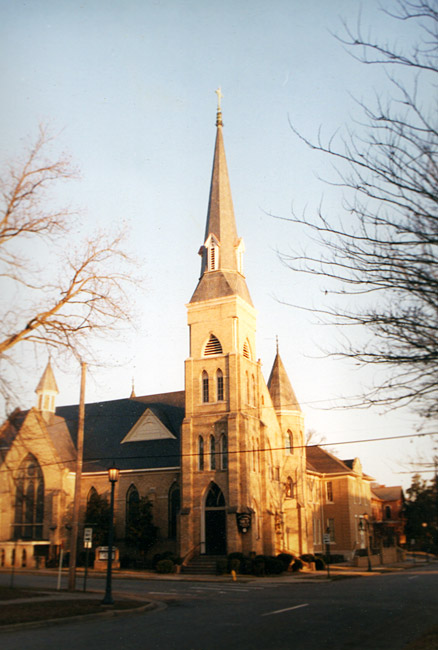
First Lutheran Church was officially organized on December 13, 1868 by a small group of 24 German immigrants who had begun meeting together for worship in a business building located on Markham and Commerce Streets in Little Rock. Within the next year they purchased the property at 8th and Holly (now Rock St.) and erected a small frame church building. Their first minister arrived that same year.
By 1884, with the growth of the congregation, they started making plans for a larger church building. The present church building was completed and dedicated to the Glory of God on April 8, 1888. Located in the MacArthur Park Historic District, the church building is now listed on the National Register of Historic Places.
The Building
The church, which seats over 400, built in the Gothic Revival style was designed by architect Thomas Harding. In 1926 a layer of buff brick was laid over the original red brick exterior making most of the walls 14 inches thick. The Cruciform plan was used with the alter facing east. The ceiling of the nave (the center portion of the church) replicates a ship which in the Christian faith is symbolic of God’s saving Grace. The narthex has entrance doors on both the east and south sides. At the east end and adjoining the narthex, are two towers. The smaller of the two contains the stairs to the choir loft which provides access to the organ and the interior of the steeple. The larger one is the bell tower in which the 1400 lb. church bell is located, approximately 85 feet above the sidewalk. Surmounting this tower is a 16 ft. Botonee Cross. In 1948 a full basement was excavated to be used as a fellowship hall.
The Altar

The altar, made in Germany of hand-carved wood, is painted with a “feathering technique” to resemble marble (faux marble). It is very similar to one of the altars in the Castle Church in Wittenberg, Germany, where Martin Luther preached and nailed the 95 theses to the door over 500 years ago. The center section portrays Christ on the cross with Mary, the mother of Jesus, and John at the foot of the cross. Facing the altar, in the right section is a portrayal of Paul with the Bible, representing the Word of God and the two edged sword of the Gospel. In the left section is a portrayal of Moses with the tablets of the Ten Commandments. The altar table has portrayals of Peter and Philip.
The Pulpit
Like the altar, Gothic in style and made of hand-carved wood, the pulpit is a masterpiece of wood carver’s art, by German artisans. It stands on a pedestal similar to those in cathedrals of Europe. The face carved into the front niche portrays Jesus Christ and the other four portray Matthew, Mark, Luke and John. There are gold gilded cherubs at each corner post and the one directly under the missal stand, where the pastor’s book of prayers and the Holy Bible rests, probably represents Gabriel.
The Baptismal Font
Also of hand-carved wood and Gothic in style, the baptismal font is octagonal in shape and stands on a pedestal like the pulpit. It is one of the three pieces of chancel furniture originally obtained as a set.
Candles
The two large candles on the altar (Communion candles) express the presence of the living Lord Jesus Christ. They help us to remember the words of Jesus,
"I am the light of the world." -John 8:12
Thus, we worship and walk in His light. The sevenfold candle stands emphasize that as we worship our Lord, we are part of the one Holy Christian Church. The candle stands have their roots in the Old Testament tabernacle and the temple. The number seven comes from the Book of Revelation which speaks of the seven candles for the seven churches.
The Eternal Light
On the south wall adjacent to the pulpit is the Eternal Light which burns continually. The burning light reminds us of Jesus who is the Light of the World and encourages us to respond with the psalmist,
The Lord is my light and my salvation; whom shall I fear? -Psalm 27:1
It was installed in 1969 as a memorial gift.
Windows
The stained glass in First Lutheran’s windows is Belz glass made in a small town in Germany. After shipping to the United States they were finished in St. Louis, Missouri by A. H. Wallis, the importer, who trained in Old World techniques using Belz glass.
The West Altar Window
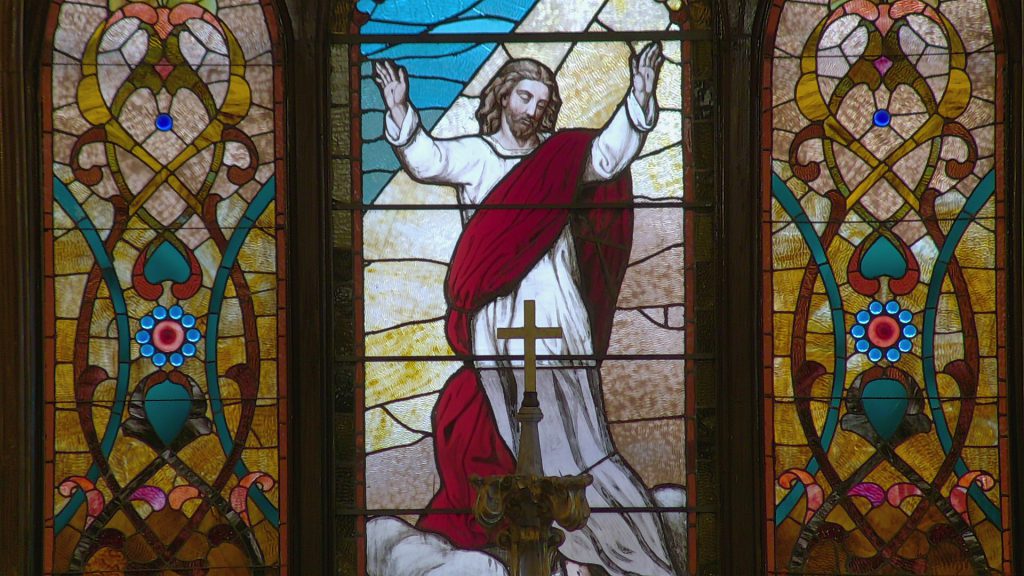
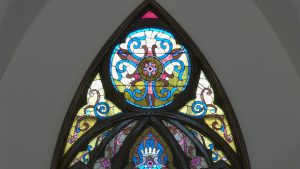
Above and behind the altar is the “Ascension Window”. This is a representation of an event that took place 40 days after the resurrection of Jesus. In the middle panel Christ ascends into Heaven with feet on the clouds. Nail prints are discernable in His hands and feet. Notes that He is not looking up, but down to us with His love. His hands are raised, blessing us. He ascended to His throne, hence the crown. The circle at the top is symbolic of the Triune God, represented in the three distinct parts of the circle.
The North Transept Window
The theme title of this window, 12 feet wide and 25 feet high, is “The Good Shepherd”. It bears the inscription,
I will seek that which was lost and bring again that which was driven away. -Ezekiel 34:16

In the center panel, the lamb being held by Jesus, is looking to Him who provides safety and protection; likewise, the lamb at Jesus’ feet. The rising sun is portrayed in the center bottom section. Note the “bulls eye” border which was in common use in Germany during the 16th century. The fixed left and right panels are primarily decorative, but do portray the vine and lily which frequently are used symbolically to remind us of Christ. In the circular window at the top is the Holy Bible. At the top of the left arch the Holy Eucharist is portrayed by the unleavened wafer and the chalice presumably containing wine. At one side is the stalk of wheat basic to the wafer and the grapevine, basic to the wine. The middle arch contains two tablets, one numbered I thru IV and the other V thru X, probably because the first four Commandments concern man’s relationship to God and the second six commandments concern man’s relationship to man. On the right is a descending dove carrying an olive branch in its beak, representing the Holy Spirit.
The South Transept Window
The theme of this window is “Jesus and the Children” and is inscribed,
"Suffer the little children to come unto Me." -Matthew 19:14
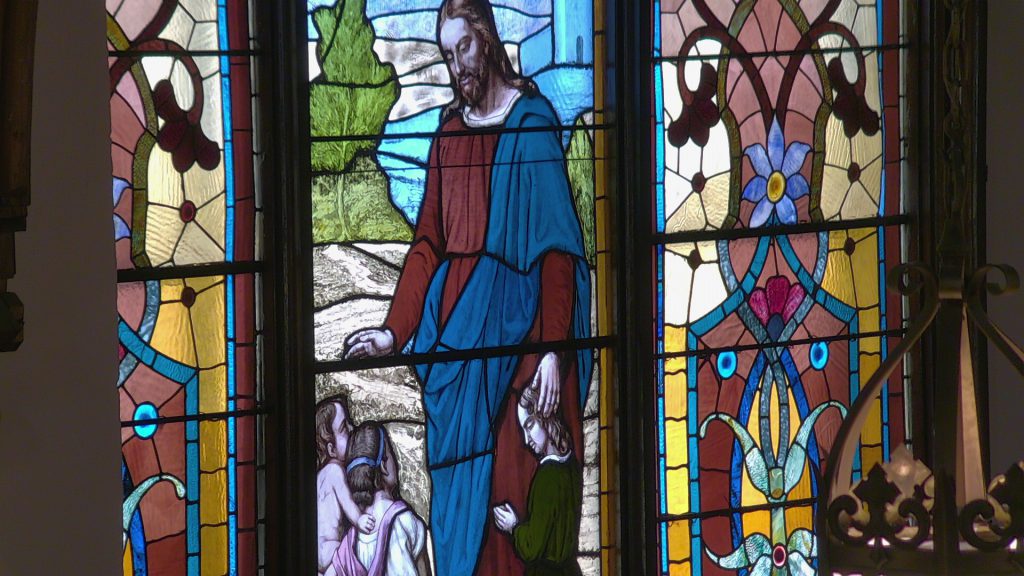
It depicts Jesus talking with and blessing the three little children in what appears to be a courtyard. Observe the facial details of Jesus and the children. Bull’s eye glass is used throughout. At the top of each panel is located from left to right, symbolic representation of the Holy Spirit (dove), the Ten Commandments and the Holy Sacrament, similar to the north transept window. Located in the top circular window is the open Holy Bible. All the names contained in the lower border were founding members who signed the 1868 charter. This window is also 12 feet wide and 25 feet high.
North and South Nave Windows
Four of these rectangular windows feature a musical lyre and are appropriate for a Lutheran church, since Martin Luther said that next to His Holy Word and theology, music is God’s greatest gift to mankind. Of the two remaining windows, one features the Greek letter ALPHA, “the beginning” and is located on the north wall. The remaining window features the Greek letter OMEGA, “the ending” and is located in the south wall. The Alpha and Omega come from Revelation, where Jesus is described as the Beginning and End of all things.
The East Organ Window
This is a circular rose window and the center feature is a symbolic representation of the Holy Spirit, the dove.
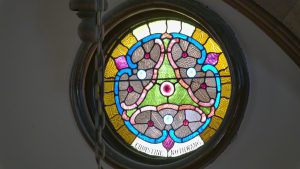
Circular Windows
There are two round decorative stained glass windows located on the upper northwest and southwest walls above the transom windows. Each symbolically represents the Triune God.
The Transom Windows
The northwest transom window was created by the artist Bernard Plockhorst, who was influenced by the historical school and was also well known for his excellent coloring. This paining is entitled, “The Empty Tomb”. It is back-lighted which enhances the coloring.
The southwest transom window is entitled “Christ in Gethsemane” and was created by Heinrich Hofmann. He was a very popular painter also known for his paining of “Child Jesus in the Temple”.
The Pipe Organ
In December 1918 the “Golden Jubilee” of First Lutheran was celebrated. At that time it was decided to purchase a new pipe organ in thanksgiving for God’s blessings over the years. A 1920 Reuter-Schwarz pipe organ was purchased by the congregation and installed. The organ was dedicated on April 11, 1920.
The Luther Education Building
The Education Building, designed by architect Charles Thompson and built in 1907, was formerly First Lutheran School. The building is now used for Sunday School, Bible classes and fellowship. The church supported and operated a Christian day school at this location from 1870 until 1965 when a new school was built on Hughes Street in west Little Rock. In 1981 the building was renovated for its present use.
The Welch Cherry House
Located adjacent to the parking lot, on the corner of 7th and Rock Streets is a historic home built in 1884. The church owns and operated this beautiful home as an event center for weddings, wedding receptions, rehearsal dinners, corporate meetings and dinners and other events. This building is has been repurposed into apartments available to rent through the church.
Thank you!
By gracious permission of his family, portions of information used were taken from Heritage of First Lutheran Church Little Rock, Arkansas 1968-1988, by Del Schmand, published in 1988. Through this writing, Mr. Schmand, a lifelong member of First Lutheran and an avid church historian, left an invaluable legacy to our church.
Please Visit Us
We hope you can join us for Sunday worship to experience the Glory of God in our beautiful church!
